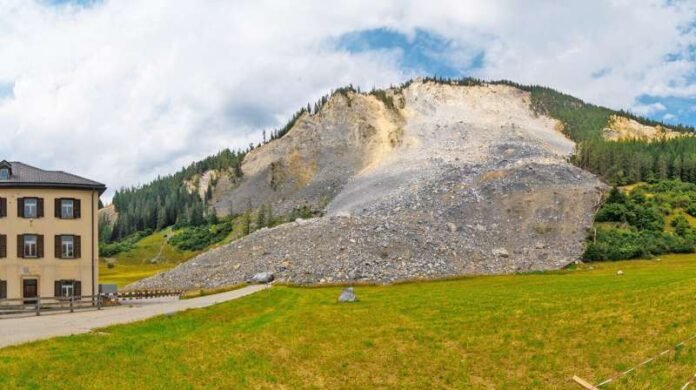by Beate Kittl, Eidgenössische Forschungsanstalt für Wald, Schnee und Landschaft WSL
During the Brienz landslide on June 16, 2023, 1.2 million tons of rock rolled into the valley. Credit: Geoprevention
On the night of June 16, 2023, approximately 1.2 million cubic meters of rock came crashing down into the valley near Brienz (GR). A team from the Swiss Federal Institute for Forest, Snow and Landscape Research WSL and ETH Zurich monitored the event using an unusual method: they detected the shock waves on underground internet fiber optic cables.
Ground waves lead to extremely small tensions and compressions in the optical fibers. Using a method called Distributed Acoustic Sensing, or DAS for short, researchers can measure these distortions in real time and even determine their origin in the fiber with an accuracy of several meters. Because optical fibers are often many kilometers long, the method is extremely interesting for remote monitoring of natural disasters.
Make use of existing infrastructure
To do this, the researchers need a dark fiber, that is, an unused fiber in a telecom cable. They connect a device to it, the interrogator, that sends laser pulses through the dark fiber. If the fiber is slightly deformed somewhere, the pulses return changed.
The method can be applied anywhere where fiber optic cables for communications are buried in the ground – which is the case in many places in Switzerland, for example along railway lines. The WSL-ETH team led by Fabian Walter, a seismologist at WSL, has already successfully recorded avalanches along the Flüela Pass using this method.

Graph of the radar measurements (top) and the measurements on underground fiber optic cables. Credit: Nayan Gurung
The rock movements in Brienz now provided a unique opportunity to test the rockfall method: the mountain was closely monitored with radar equipment and seismometers before and during the rockfall, and the Swisscom Broadcast AG company gave Fabian Walter access to a fiber optic cable running between Tiefencastel and Filisur.
The researchers sent laser pulses through this cable for 45 days with the help of an interrogator from the Seismology and Wave Physics Group at ETH Zurich, until the landslide started on the night of June 15-16. “The measurements exceeded our expectations,” says Walter. “We were able to measure hundreds of small rock falls before the big event, and the big fall anyway.”
The hardest part about fiber optic detection is filtering the signals they are looking for from the countless other vibrations caused by trains, traffic or rivers. WSL PhD candidate Jiahui Kang used artificial intelligence to develop an algorithm that automatically recognizes the signals.
It was able to correctly identify 95% of rock movements, the researchers report in the journal Geophysical research letters. For comparison, radar measurements from the Geoprevent company, which monitored the Brienzer rockslide area, were used.
Huge amounts of data
What prevents widespread use of the fiber optic method if it works so well? According to Fabian Walter, there are several obstacles: the calculation models to filter the desired signals from the noise are still only in the research phase. The measurements also collect enormous amounts of data, which can amount to several terabytes per day. “You first have to learn how to analyze the data in real time,” says Walter.
Last but not least, the interrogators are still very expensive: over CHF 100,000 (~115,000 USD), but the trend is downward. Walter expects these issues to be resolved in the coming years, stating, “This information is too valuable not to be used.”
The fiber optic method can potentially monitor rockfalls, avalanches, earthquakes and debris flows with local precision and over long distances. All it takes is a fiber optic communications network – and this continues to grow worldwide.
More information:
Jiahui Kang et al., Automatic monitoring of rock slope failures using distributed acoustic sensing and semi-supervised learning, Geophysical research letters (2024). DOI: 10.1029/2024GL110672
Provided by Eidgenössische Forschungsanstalt für Wald, Schnee und Landschaft WSL
Quote: Internet Fiber Optic Cables Successfully Detect Shock Waves from a Landslide (2024, October 22) retrieved October 22, 2024 from https://phys.org/news/2024-10-internet-fiber-optic-cables-successfully.html
This document is copyrighted. Except for fair dealing purposes for the purpose of private study or research, no part may be reproduced without written permission. The content is provided for informational purposes only.





